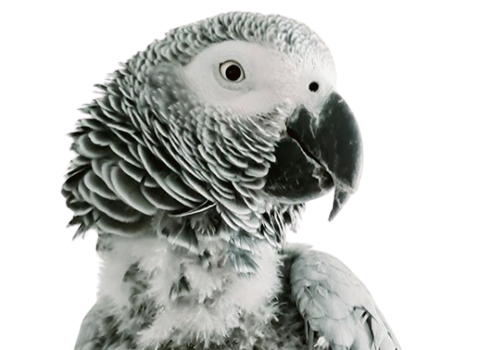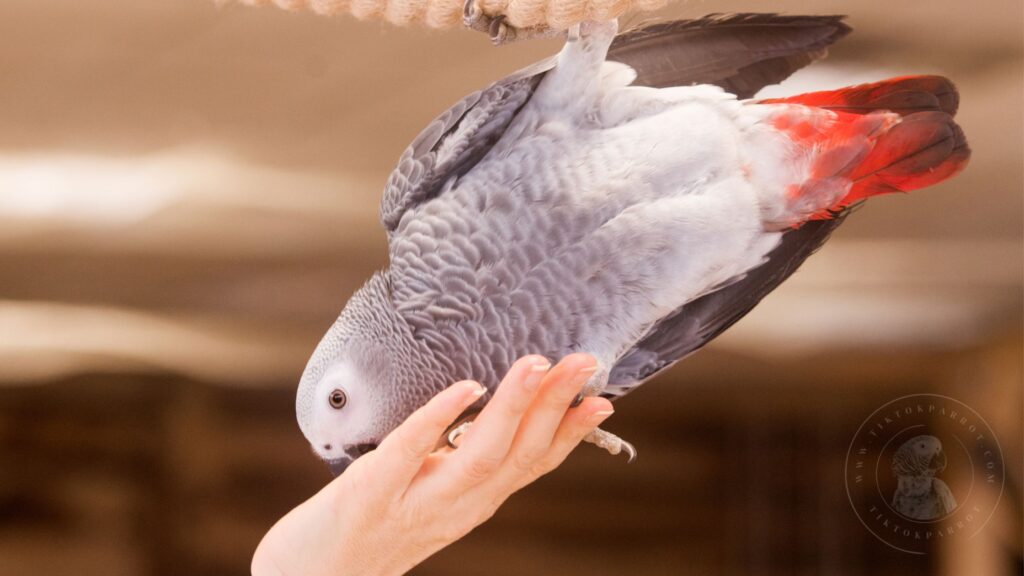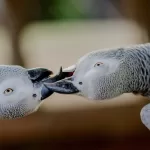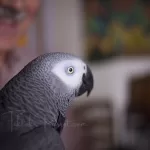Welcome to TikTokParrot, your one-stop shop for all things feathery and fun!
Today, we’re delving into the fascinating world of African Grey parrot touch. Did you know these intelligent birds not only see and hear the world around them, but they also feel it in surprising ways? From their mighty beaks to their teeny-tiny toes, let’s explore how touch plays a crucial role in their lives.
African Grey Parrot Touch Sense: A World at Their Feet
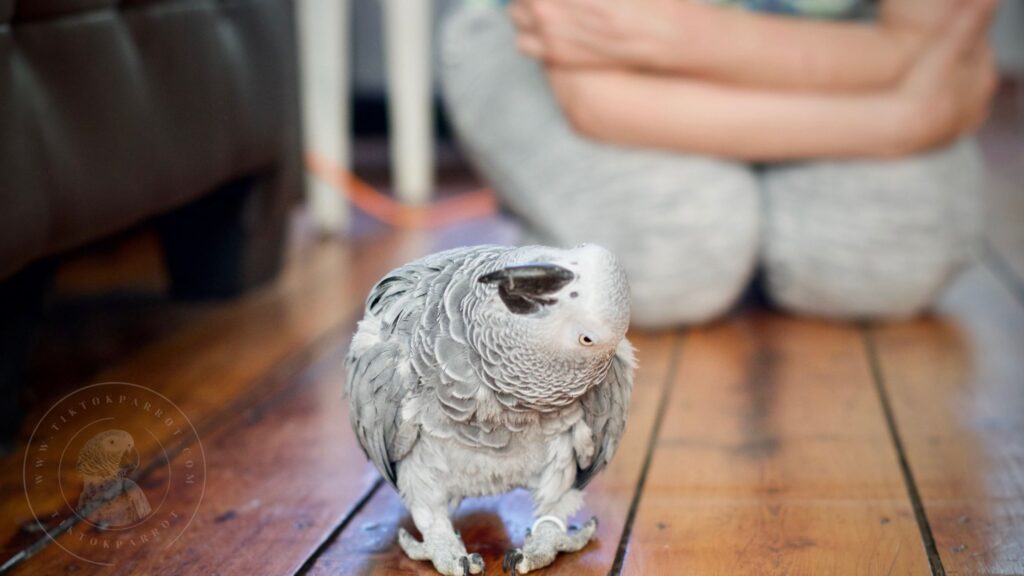
Ever wondered why your African Grey loves foot toys so much? It’s not just about entertainment! Their feet are packed with mechanoreceptors, tiny sensory organs that act like little maps, registering:
- Texture: They can differentiate between smooth, rough, bumpy, and even sticky surfaces. This helps them navigate their environment, identify objects, and determine if something is safe to climb on.
- Temperature: Sensitive to hot and cold, they use their feet to assess the temperature of their perches, toys, and even their human companions.
- Vibration: Their feet can pick up on even the slightest vibrations, making them incredibly aware of their surroundings. This can be helpful for balance and even communication, as some parrots use foot tapping to express themselves.
African greys feet are incredibly sensitive! Packed with nerves, those feet are like little sensory maps. They register texture, temperature, and even subtle vibrations. It’s no wonder they enjoy foot toys so much!
The Beak: A Multi-Tool
An African Grey’s beak is more than just a nutcracker; it’s a precision instrument for exploring the world. Think of an African Grey’s beak as their third hand! It’s a complex and versatile tool used for more than just cracking nuts. They utilize their beaks for a variety of touch-related tasks, including:
- Preening: Their beaks act like tiny combs, meticulously grooming and cleaning each individual feather. The delicate touch allows them to assess the condition of their plumage and remove dirt or parasites.
- Playtime: From shredding toys to manipulating intricate objects, their beaks exhibit remarkable dexterity. This playful exploration helps them learn about textures, shapes, and cause-and-effect.
- Social Interaction: Gentle nibbles or nuzzles from a bonded Grey are their way of expressing affection and strengthening the bond with their trusted humans. However, it’s important to note that the pressure and context of these touches can vary, so always be mindful of your Grey’s body language.
Not Just Feathers: Skin Sensation
While feathers may seem like a protective layer, the skin underneath is also surprisingly sensitive to touch. Observe how your Grey reacts to gentle strokes on their head or scratches under their wings. These light touches send signals through their nervous system, providing sensory information and influencing their behavior.
Why Texture Matters
Parrots, especially African Greys, are fascinated by different textures. Observe them closely, and you’ll see how they explore new objects:
- The Foot Test: A new perch gets a thorough toe inspection before they step onto it.
- Beak Exploration: From soft fabrics to rough wood, their beaks help them categorize the things they encounter.
- Aversion Alert: Some textures can be downright unpleasant, eliciting a squawk and a quick retreat.
The Fascination with Texture: A World Explored by Touch
African Greys, like many parrots, are highly inquisitive creatures and possess a natural curiosity about textures. Watch them closely as they encounter new objects:
- The Foot Test: Before stepping onto a new perch, they’ll often give it a thorough “toe inspection,” gauging its texture and stability.
- Beak Exploration: From soft fabrics to rough wood, they’ll use their beaks to investigate the texture and material of different objects, gathering information about their surroundings.
- Aversion Alert: Some textures can be unpleasant or even frightening for them, triggering a squawk or a quick retreat. This aversion can help them avoid harmful materials or uncomfortable situations.
The Emotional Connection: How Touch Impacts Their Feelings
Touch plays a significant role in an African Grey’s emotional well-being:
- Comfort and Bonding: Gentle touch from a trusted caregiver, like their human companion, can provide comfort and strengthen the bond between them. This positive touch can be calming and stress-relieving, similar to how cuddling can benefit humans.
- Stress Signals: When stressed or uncomfortable, an African Grey might exhibit physical signs like shivering, fluffing their feathers, or withdrawing from touch. Recognizing these signals is crucial to understanding their emotional state and addressing any underlying issues.
- Setting Boundaries: It’s essential to respect your Grey’s individual boundaries. Biting can sometimes indicate they feel overwhelmed, scared, or uncomfortable with being touched. Pay attention to their body language and allow them space when needed.
Living with a Touch-Sensitive Avian
Understanding your African Grey’s sense of touch can significantly enhance your relationship and create a harmonious living environment:
- Touch Training: Gentle, positive reinforcement training sessions using touch can help build trust and familiarity with your hands. This can be helpful for handling, grooming, and veterinary checkups.
- Supervised Playtime: Provide a variety of parrot-safe toys with diverse textures to stimulate their natural curiosity and exploration. Ensure all toys are free of sharp edges, small parts, and harmful materials.
- Respecting Their Space: Like any individual, your Grey will have times when they simply prefer solitude. Observe their body language and respect their need for alone time. Avoid forcing physical interaction if they seem withdrawn or disinterested.
Remember:
My Final Thoughts
From the tips of their toes to the ends of their beaks, African Greys experience the world through an intricate sense of touch. Building a trusting relationship with your African Grey takes time, patience, and an understanding of their unique needs.
Understanding how they feel things helps us connect with them on a deeper level and provide the best possible care. By recognizing the importance of touch in their lives and respecting their individual preferences, you can create a bond built on mutual respect, love, and understanding.
How does your African Grey react to different textures or types of touch? Share your stories in the comments!
If you found this blog helpful, It would be great if you could share it with your family and friends who might find it useful as well.
You might like to read these as well 🙂
African Grey Parrots: Do They Have a Secret Sense of Smell?
African Grey Parrots: Do They Have a Sixth Sense? (You Won’t Believe These Stories)
Poop or Perch: Understanding Your Parrot’s Bathroom Body Language
Confessions of an African Grey Owner: The Good, The Bad, and the Feathered
African Grey Parrot Taste Sense: Taste Bud Adventures
African Grey Mutations: Everything You Need to Know
African Grey Parrot Temperament
For more useful content about African grey parrots, you can subscribe my site with your email to get notification upon publishing a new blog, the subscribe box you can see on the right side of this page. Also if you get an alert on your web browser while browsing my site, allow it and that will also give you an alert whenever I publish a new blog. 🙂
Stay safe and much love!


Hey there! 🐾 Looking for top-notch pet supplies or anything on Amazon?
Support our site by shopping on Amazon through our this referral link, it will not cost you extra!
Your purchases on Amazon can help us continue providing valuable content.
Thank you for your support! 🛍️
